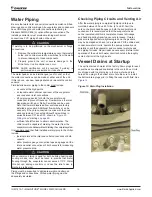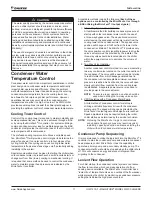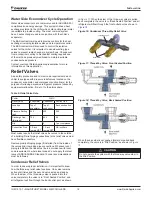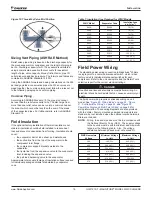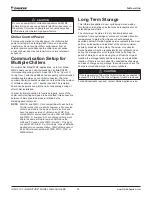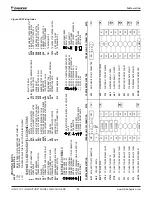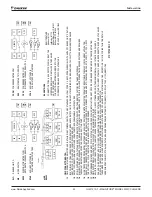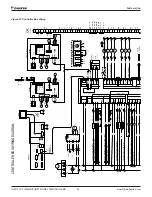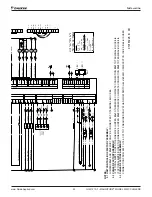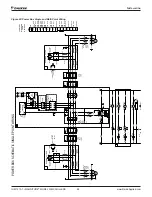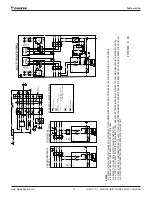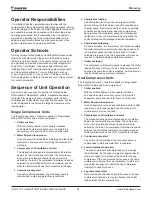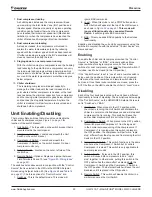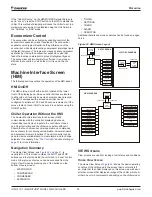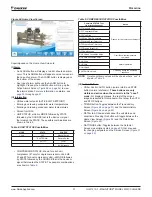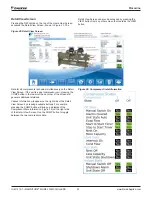
www.DaikinApplied.com 17
IOM 1210-7 • MAGNITUDE
®
MODEL WMC CHILLERS
I
nsTallaTIon
CAUTION
The water quality provided by the owner/occupant/operator/
user to a chiller system should minimize corrosion, scale
buildup, erosion, and biological growth for optimum efficiency
of HVAC equipment without creating a hazard to operating
personnel or the environment. Water systems should be
cleaned and flushed prior to the chiller installation. Water
testing and treatment should be verified during initial chiller
installation/commissioning and maintained on a continuous
basis by water treatment professionals (see Limited Product
Warranty).
The use of detergents, chemicals, and additives in the chiller
system water may adversely affect chiller performance and
potentially lead to repair costs not covered by warranty.
Any decision to use these products is at the discretion of
the owner/occupant/operator/user as such they assume full
liability/responsibility for any damage that may occur due to
their use.
Condenser Water
Temperature Control
Condenser water control is an important consideration in chiller
plant design since condenser water temperature will directly
impact chiller operation and efficiency. When the ambient
wet bulb temperature is lower than peak design, the entering
condenser water temperature from the cooling tower can
be allowed to fall, improving chiller performance. However,
operational issues may occur when the condenser water
temperatures are either too high or too low. The WMC chiller
provides several options to assist the chiller plant designer in
providing the optimum control of condenser water temperature.
Cooling Tower Control
Control of the cooling tower is required to maintain stability and
avoid operational issues. This can be achieved through a BAS
or by using the MicroTech
®
II controller. For systems utilizing a
common condenser water loop for multiple purposes, the BAS
contractor must provide the control but use of the MicroTech
®
II
output signal is still recommended.
The preferred cooling tower control utilizes a variable speed
fan. MicroTech
®
II will provide a control signal to determine the
proper fan speed. It can also control up to four stages of fan
cycling. Note that fan cycling can cause cooling tower water
temperature to fluctuate as fans stage on/off, potentially adding
instability to the system.
Special consideration must be given to starting the chiller when
cold condenser water is present, such as with inverted starts or
changeover from free (tower) cooling to mechanical cooling. It
is required that some method be used to control the condenser
water to maintain proper head pressure as indicated by the
MicroTech
®
II controller.
Acceptable methods include the following
(Each of these
options can be controlled by the MicroTech
®
II or through
a BAS utilizing the MicroTech
®
II output signals .)
:
1. Three-Way Bypass Valve Operation
A traditional method for building condenser pressure at
startup with colder condenser water is with the use of
a three-way bypass valve. The device blends warmer
water leaving the condenser with cooler water from the
cooling tower at the condenser inlet. The bypass valve
position will change until full flow from the tower to the
condenser is obtained. The MicroTech
®
II provides only
the valve position control signal. Main power to drive the
valve’s actuator must be provided by the installer. The
three-way valve should be located close to the chiller
within the equipment room to minimize the volume of
water.
2. Two-Way Valve Operation
Another condenser control method is to use a modulating
two-way control valve located on the outlet connection of
the condenser. The valve will be nearly closed at startup
to restrict water flow, which keeps generated heat in
the condenser until an acceptable minimum condenser
pressure is reached. As heat builds, the valve will open
slowly until a full flow condition from the cooling tower
is established. A separate power source is required to
provide power to the valve actuator.
NOTE:
To ensure proper operation, caution should be
used when utilizing the two-way valve option.
3. VFD Operating with a Condenser Water Pump
A third method of condenser control for startup is
utilizing a variable frequency drive with the condenser
water pump. The speed will change as directed by the
MicroTech
®
II output signal until design flow is reached.
Speed adjustments may be required during the initial
chiller startup as determined by the service technician.
NOTE:
Not using the MicroTech
®
II logic to control valves
and variable frequency drives may result in system
instability, capacity reduction, and issues starting the
chiller with cold condenser water temperature.
Condenser Pump Sequencing
It is recommended to utilize the logic built into the MicroTech
®
II
controller to start the condenser pump and maintain condenser
head pressure control. MicroTech
®
II has the capability to
operate a primary pump and a secondary standby pump. The
condenser water flow should be stopped when the chiller shuts
off. This will conserve energy and prevent refrigerant from
migrating to the condenser.
Lenient Flow Operation
For chiller startup, the condenser control systems can reduce
the flow to low rates, which can make operation of a flow
sensing device unreliable. The MicroTech
®
II controller has a
“lenient flow” feature that acts as an override of the flow sensor
while protecting the chiller by monitoring a condenser pressure
setting that is below the high pressure cutout.














